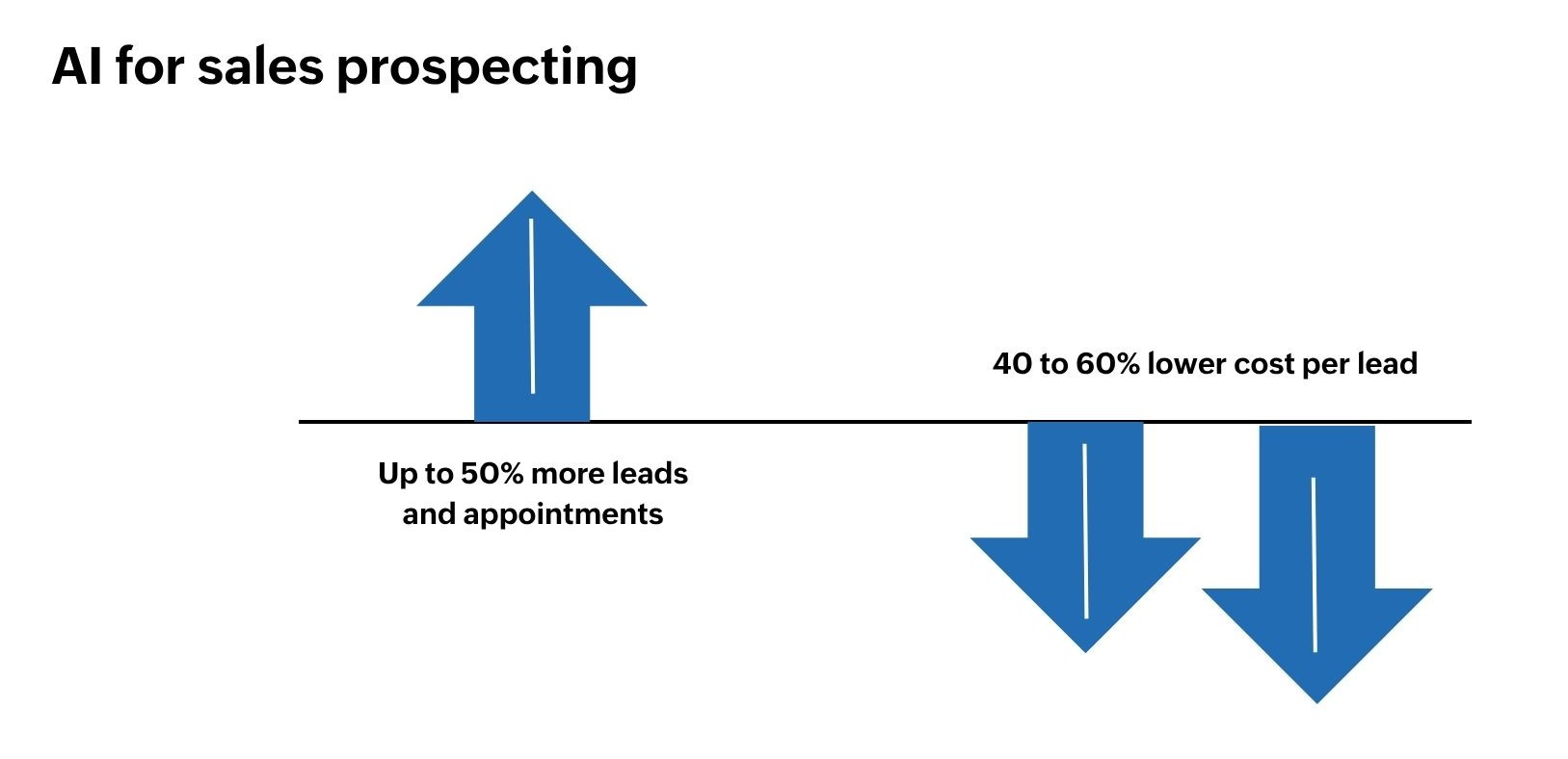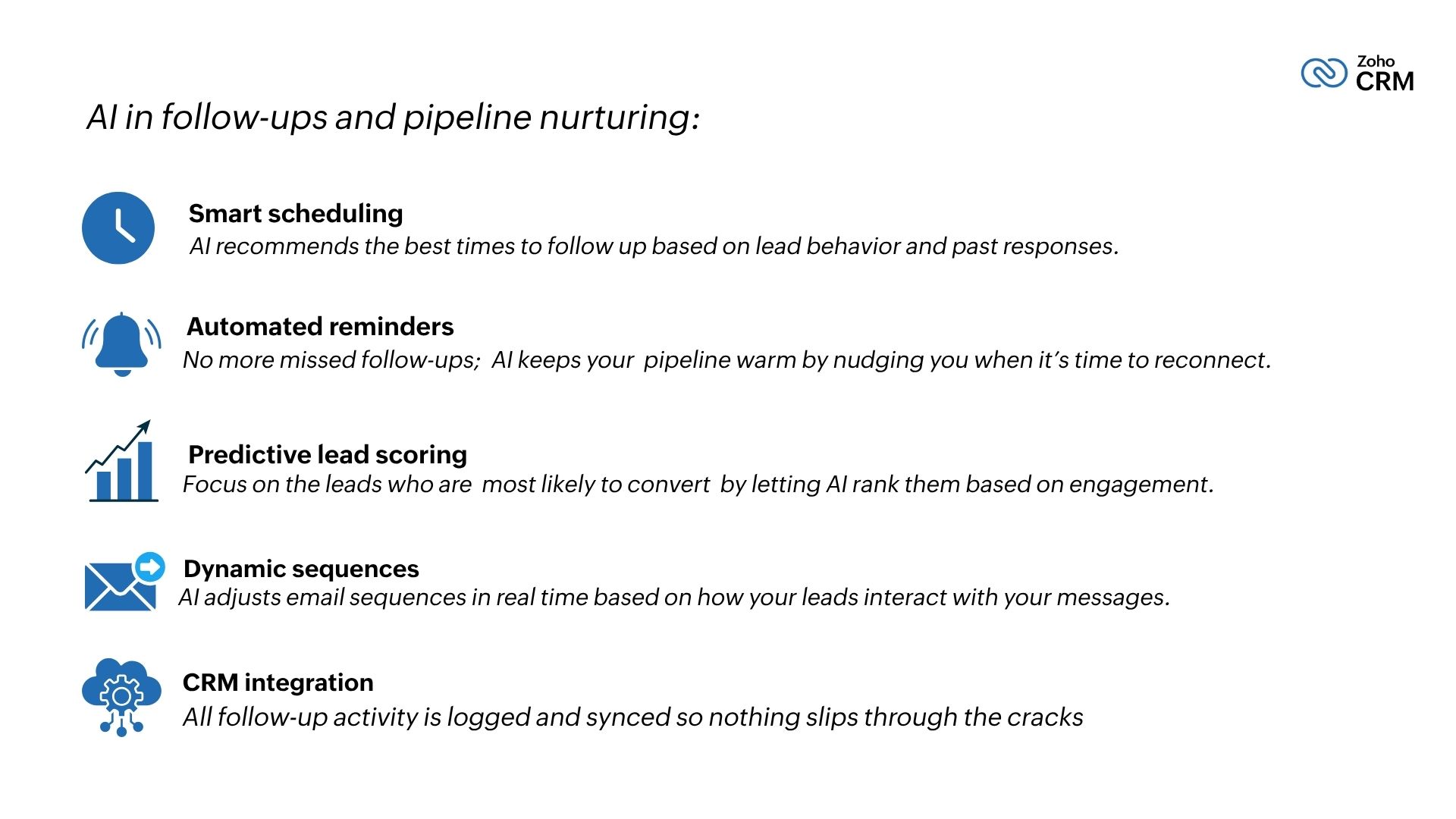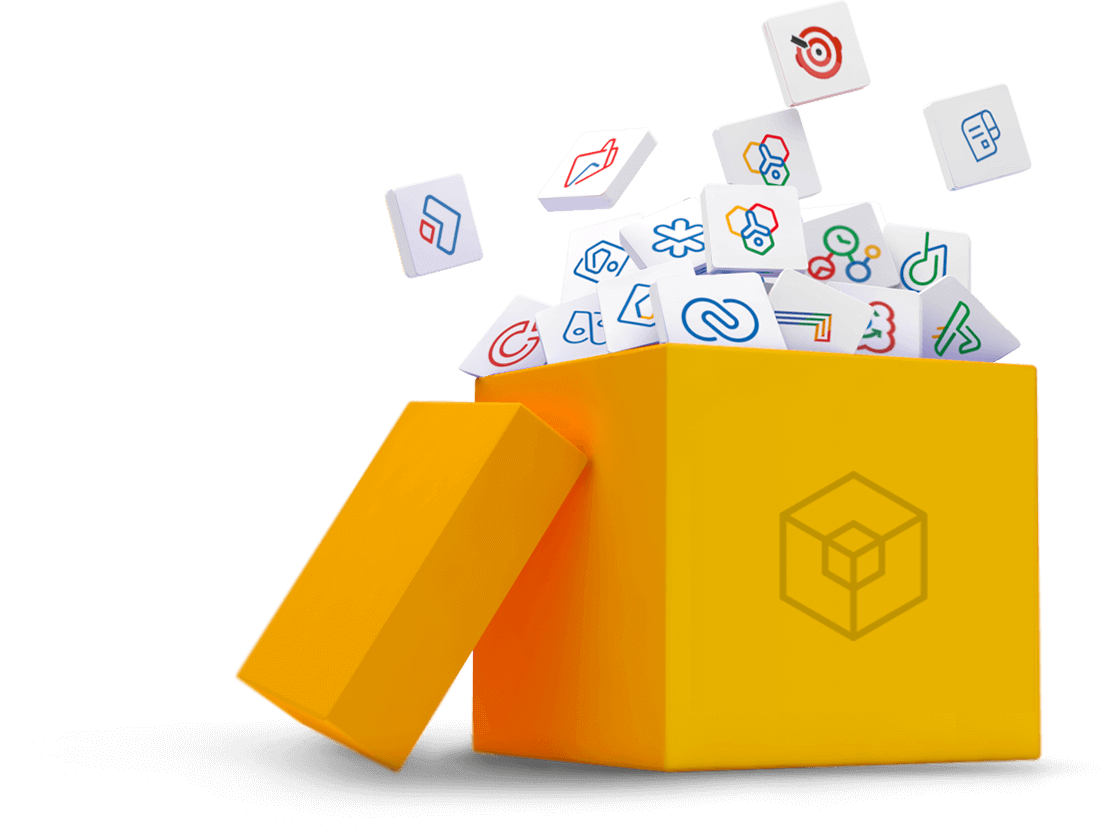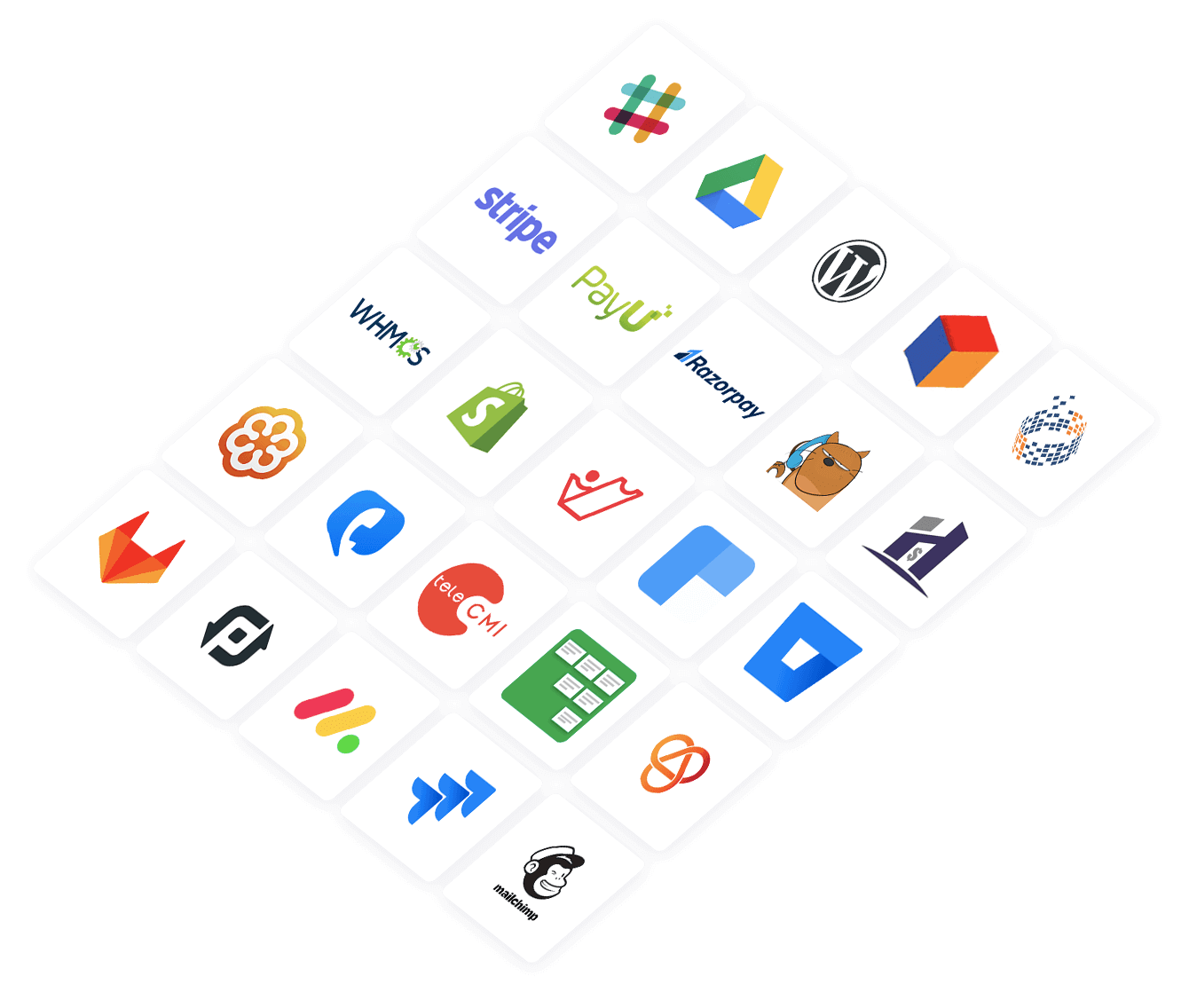How AI can supercharge your sales prospecting
- Last Updated : July 1, 2025
- 68 Views
- 7 Min Read

Sales prospecting is the heartbeat of any successful sales journey; it's where opportunities begin and relationships are built. It requires time, focus, and strategy, and even then, the results can be unpredictable. Reaching out to the right people—at the right time and with the right message—has often felt like a mix of research, skill, and luck.
Increasingly, sales professionals find themselves spending time looking for leads than actually engaging with them. Manually searching for prospects, crafting cold emails, and managing follow-ups can quickly become overwhelming, especially when the lack of proper tools or insights leaves you doing the work without seeing the results.
This is exactly where AI is making a difference.
With the ability to analyze vast amounts of data, identify patterns, and deliver real-time insights, AI is helping sales teams work smarter by enabling them to focus on leads with higher chances of conversion, personalize their outreach, and streamline their workflows so they can spend more time doing what truly matters: building relationships and closing deals. Contrary to common belief, AI isn't here to replace the human element in sales; it's here to enhance it.
If you ever feel prospecting is more about guesswork than strategy, it's time to add AI to your sales toolset.
How AI can help you find better leads in less time?
One of the biggest challenges in prospecting is knowing where to start. With thousands of potential customers out there, how do you figure out who's actually worth your time? That's where AI can really help.
Instead of spending hours manually filtering through lists or guessing who might be a good fit, AI helps you identify and prioritize high-quality leads based on historical trends. It looks at patterns from your past wins, analyzes buyer behavior, and even tracks important company developments like funding rounds, job postings, and recent news mentions. This analysis gives you a clear idea of who's most likely to convert and who's not.
In fact, according to a McKinsey report, companies that use AI for sales prospecting have seen up to a 50% increase in leads and appointments, and a 40 to 60% reduction in cost per lead.

With AI tools at your disposal, you can finally spend less time searching for leads and more time connecting with the right ones. It transforms lead generation and conversion from a numbers game into a strategy that drives success. That means you're getting better results and are using your time more efficiently.
The best part? You don't need to be a data expert to benefit from it. The tools do the heavy lifting for you so you can focus more on having conversations and less on understanding spreadsheets of data.
Stay updated with real-time context
Imagine reaching out to a lead just as their company announces a major expansion or closes a fresh funding round. That timing can completely change the outcome of your message. With AI, you won't be left to stumble across these updates just by chance; you're kept in loop automatically.
A study by InsideSales.com shows that reaching out within five minutes of a trigger event makes you 100 times more likely to connect with the lead. AI tools scan the web, track recent company developments, and pull in relevant updates about your prospects in real time. Whether it's a leadership change, a product launch, or a recent funding round, you get insights that can help you start conversations that are timely and relevant.
With the help of these insights, instead of sending out generic messages, you can reach out to prospects with a message like, “Congrats on the new product launch! Looks like things are moving fast on your end. I'd love to show you how we can help support that momentum.”
It's simple, right? But so much more effective than a cold, one-size-fits-all pitch.
Personalize outreach at scale with less effort
Crafting the right message has always been at the core of successful sales prospecting, but doing it again and again—for every lead, follow-up, and touchpoint? That takes time and can easily start to feel repetitive. Thankfully, AI-driven content generation is proving to be hugely beneficial for sales personnel.
AI doesn't just help you write faster; it helps you write smarter. With the ability to analyze prospect data, behavioral cues, and previous interactions, AI can generate personalized emails, follow-ups, and even LinkedIn messages that feel human, not automated.
Instead of starting from scratch each time, AI can help generate message templates tailored to each lead's industry, pain points, and engagement history. Some AI tools can even adapt tone and structure based on your brand voice and communication style. That means you maintain consistency while still speaking directly to your prospects in a way that feels relevant and personal.
Writing personalized outreach day after day can drain your creativity. AI tools like Zia can records summaries, insights, and context in each record—everything from past interactions to data trends .
They can also generate recommended actions, next steps, or follow-up reminders based on what's happening in each account. You still control the message, but Zia gives you the clarity and context you need. You don't have to wait for an end-of-the-month report to detect deviations in sales activities and numbers; with these AI tools, you can get real-time updates on anomalies and act on them instantly. These platforms can even detect imminent anomalies in your sales trends, giving you enough time to prevent a dip in revenue or gear up for a spike in incoming leads.
When you can automate the repetitive parts of communication and still maintain a personal touch, your prospecting becomes not just more efficient but more effective.

Strengthen follow-ups and pipeline nurturing with AI
In sales, consistent follow-up is critical, and it's often where deals fall through. Prospects rarely convert after a single interaction, and staying engaged throughout the buying journey requires precision, persistence, and timing.
AI tools support sales teams by intelligently managing follow-up sequences. They analyze lead activity, suggest the best times to re-engage, and automatically schedule reminders or even initiate follow-up emails based on prior engagement. This makes your outreach timely and relevant, so your prospects don't find it random or forced.
One of AI's greatest advantages here is predictive lead scoring. Instead of manually guessing which prospects to prioritize, AI ranks leads based on how likely they are to convert using data like email open rates, website visits, and interaction history. This enables you to invest your energy in the right conversations at the right times.
According to Invesp, 80% of sales require at least five follow-ups, but 44% of sales professionals give up after just one. AI helps bridge that gap by taking on the burden of consistency, so you can focus on meaningful, high-quality interactions. It can also adapt the messaging to a lead's behavior by adjusting email tone, frequency, or content to fit their preferences. This level of responsiveness helps build trust and keeps your pipeline active and moving forward.

Smarter forecasting and decision-making
A clear view of your sales pipeline can make all the difference when it comes to driving results. It helps you track progress, identify bottlenecks, and stay aligned with your goals. But pipeline visibility alone isn't enough; what's important for your sales strategy is the ability to anticipate what's coming next. That's where forecasting steps in.
Forecasting isn't just about projecting revenue but about planning resources, aligning teams, identifying and mitigating potential risks before they become roadblocks. Traditionally, forecasting has relied heavily on intuition and historical data, which leaves room for human error or bias. AI adds clarity, accuracy, and up-to-the-minute insights that take the guesswork out of forecasting. AI-powered forecasting tools assess current pipeline health, analyze past performance, and track real-time engagement metrics to provide accurate predictions. They can also flag deals that are at risk of stalling to help sales managers intervene and adjust strategies. With the right data and tools, you can move beyond reacting to what's in front of you and start predicting outcomes with confidence.
Building on the power of accurate forecasting, AI also enables a deeper understanding of customer behavior, particularly when it comes to churn. Churn prediction empowers you to analyze usage trends, engagement patterns, and historical data to help you identify early signs of potential churn. With these insights, your team can take timely, targeted actions to retain high-risk customers and strengthen long-term relationships. It's not just about predicting outcomes anymore; it's about preventing losses before they happen.
Drawing the curtain with AI
Prospecting has never been easy; it demands time, strategy, and a deep understanding of your leads, all while managing shifting priorities and an increasingly competitive landscape. But with AI, you're no longer navigating this process blindly.
AI empowers your sales process with clarity, speed, and insight. From identifying high-value leads to sending timely, personalized outreach and nurturing every opportunity through intelligent follow-ups, it empowers you to be more efficient without losing the personal touch that makes sales truly meaningful.
Moreover, this shift isn't a distant future; it's already happening. Sales teams that embrace AI are seeing stronger engagement, better forecasting, and measurable improvements in pipeline performance.
If prospecting has ever felt like a shot in the dark, it's time to flip the script. Let AI do the heavy lifting so you can double-down on what truly drives results: building meaningful connections, delivering value, and accelerating revenue with clarity and confidence.




